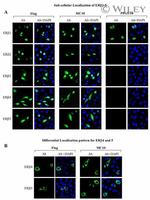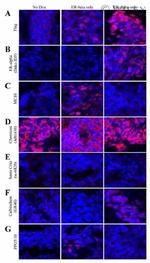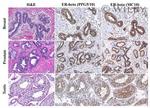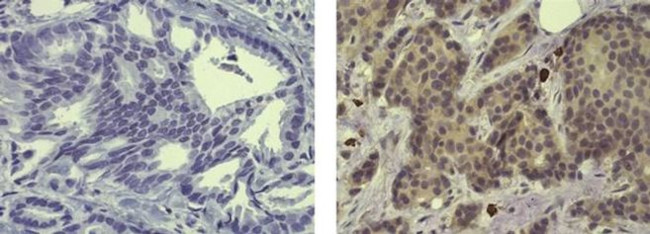Search Thermo Fisher Scientific
Invitrogen
Estrogen Receptor beta Monoclonal Antibody (MC10), eBioscience™
图: 1 / 5
Estrogen Receptor beta Antibody (14-9336-82) in IHC (P)





产品信息
14-9336-82
种属反应
已发表种属
宿主/亚型
分类
类型
克隆号
偶联物
形式
浓度
纯化类型
保存液
内含物
保存条件
运输条件
RRID
产品详细信息
Description: The MC10 monoclonal antibody recognizes all forms of human estrogen receptor (ER) beta. ER beta is a member of a superfamily of nuclear receptors, which are ligand-dependent transcription factors. ER beta like ER alpha, becomes activated by binding the hormone estrogen, causing a dissociation from chaperone proteins and subsequent dimerization with either ER beta or ER alpha. Unlike ER alpha, the result of ER beta signaling is thought to be anti-proliferative and proapoptotic. The MC10 clone recognizes full length ER beta as well as each of its splice variants.
Applications Reported: This MC10 antibody has been reported for use in immunoprecipitation, western blotting, immunohistochemical staining of formalin-fixed paraffin embedded tissue sections, microscopy, ELISA, and immunocytochemistry.
Applications Tested: This MC10 antibody has been tested by immunohistochemistry on formalin-fixed paraffin embedded human tissue using either low or high pH antigen retrieval and can be used at less than or equal to 30 µg/mL. It is recommended that the antibody be carefully titrated for optimal performance in the assay of interest.
Purity: Greater than 90%, as determined by SDS-PAGE.
Aggregation: Less than 10%, as determined by HPLC.
Filtration: 0.2 µm post-manufacturing filtered.
靶标信息
Estrogen Receptor beta (ER beta, NR3A2) protein is approximately 55kD, though multiple isoforms ranging from 36-59kD have been described. Human ER beta was initially cloned and characterized from testis. Estrogen Receptors (ER) are members of the steroid/thyroid hormone receptor superfamily of nuclear receptors. The estrogen receptor is a ligand-activated transcription factor, that when bound to estrogen hormone, induces a conformational change that allows dimerization and binding to estrogen response elements (ERE) in DNA. When bound to EREs, ER can positively or negatively regulate gene transcription through the recruitment of coactivator or corepressor proteins. There are two different forms of the estrogen receptor, alpha and beta, encoded by separate genes (ESR1 and ESR2, respectively). Estrogen receptor beta (ER beta) binds estrogens with an affinity similar to that of estrogen receptor alpha. Some ER beta isoforms dominantly inhibit the activity of estrogen receptor alpha in reproductive tissues. ER beta is found widely in many tissues throughout the body and can act as a potent tumor suppressor, playing a crucial role in many cancer types such as prostate cancer, autism spectrum disorder, medullary thyroid carcinoma, De Quervain Disease and risk of cardiovascular disease.
仅用于科研。不用于诊断过程。未经明确授权不得转售。
生物信息学
蛋白别名: ER beta; ER-beta; estrogen receptor 2 (ER beta); Estrogen receptor beta; estrogen receptor beta 4; Nuclear receptor subfamily 3 group A member 2
基因别名: ER-BETA; Erb; ESR-BETA; ESR2; ESRB; ESTRB; NR3A2
UniProt ID: (Human) Q92731
Entrez Gene ID: (Human) 2100



